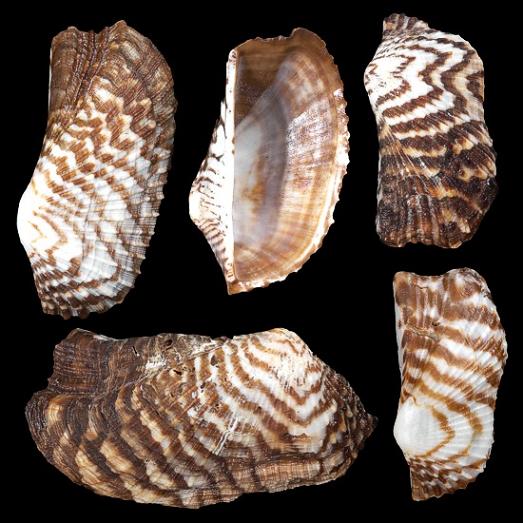As the site is updated, each listing includes the shipping cost. Some listings which I have not updated still give you calculated shipping costs based on weight and size of package. (In the sections I have updated) If you select several different listings, we will consolidate your order and charge you the actual cost of the entire package. The shipping over charge will be refunded to you, when your order is shipped.
THE POPULAR, COLORFUL TURKEY WING SHELL

Turkey Wing Shells
Arca zebra, commonly known as the turkey wing ark clam or simply turkey wing, is a bivalve mollusk belonging to the family Arcidae, which encompasses ark clams.
Turkey wings are found along the Atlantic coast of North America, ranging from North Carolina to the West Indies and Bermuda. It attaches itself to rocks or other hard substrates in shallow water with byssus threads.
TThe shell of Arca zebra is strikingly striped in brown and white, resembling the wing of a wild turkey. When both valves are joined, the entire shell is also reminiscent of Noah's Ark. This robust shell can grow up to 4 inches in length and 2 inches in width. The umbones are divided by a shallow depression, and the hinge is elongated and straight, featuring approximately 50 small teeth. Coarse sculpturing radiates from the umbones, and the interior of the shell is either whitish or a pale mauve.
Arca zebra is a filter feeder, taking in surrounding water and particulates through its reduced siphons and expelling water while consuming microscopic algae, diatoms, and phytoplankton.
The Arca zebra is a protandric hermaphrodite, which means individuals initially mature as males and later develop the capacity for female reproduction. Its reproductive cycle is influenced by food availability and seasonal variations. Throughout the year, the gonad tissue mass of Arca zebra fluctuates. From May to late September, the proportion of gonad tissue mass to somatic tissue mass significantly increases from about 4% to 40%, then sharply declines from approximately 40% to 3% from October to January. This percentage experiences a minor rise from 3% to 12% in February, then falls back to around 4% between March and April. The peak of reproductive activity is observed from July to late September, coinciding with the highest gonad mass. Gonad development in Arca zebra starts when their shells measure 18-20mm, and they reach full sexual maturity at a shell size of 50-55mm. Individuals with larger shells have a higher reproductive output.
The Arca zebra species experiences two reproductive seasons, occurring from June to July and again in September. During each spawning event, a female may release up to four million eggs. Trochophore larvae, which are a form of planktonic larvae, start to develop within twelve hours post-fertilization. By the sixth day, these larvae start assuming their adult form. Eyespots appear on the seventh day, followed closely by the development of the foot. Concurrently, the larvae exhibit food-seeking behaviors in the substratum, the sediment layer on the ocean floor. By the twelfth day, the larvae begin to settle, with approximately 45% reaching this phase. After reaching maturity, the larvae's growth is predominantly in the summer, occurring nearly three times faster than in the winter.
Scientific classification
Domain: Eukaryota
Kingdom: Animalia
Phylum: Mollusca
Class: Bivalvia
Order: Arcida
Family: Arcidae
Genus: Arca
Species: Arca zebra
Binomial name: Arca zebra
(Swainson, 1833)
(REF:Arca zebra (Swainson, 1833) World Register of Marine Species.)(REF:Abbott, R.T. & Morris, P.A. A Field Guide to Shells: Atlantic and Gulf Coasts and the West Indies. New York: Houghton Mifflin, 1995)(REF: "turkey wing - Encyclopedia of Life". eol.org)(REF: LISTA, MARÍA; Lodeiros, Cesar; PRIETO, ANTULIO; HIMMELMAN, JOHN; Castaneda, Julian; GACÍA, NATIVIDAD; VELAZQUEZ, CARLOS (2006-12-01). "Relation of seasonal changes in the mass of the gonad and somatic tissues of the zebra ark shell Arca zebra to environmental factors". Journal of Shellfish Research. 25 )
P1-2-9
ATurkey Wing shell measuring 1 to 2 1/2 inches (not matching pair of this bivalve)...... .09